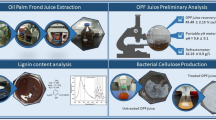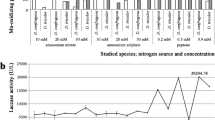Summary
Xylose, the predominant sugar in red oak prehydrolysate, is fermented to ethanol byPichia stipitis CBS 5776. Toxic model compounds derived from red oak hemicelluloses, lignin, and extractives inhibited the fermentation. Treatment of the prehydrolysate with molecular sieve and mixed bed ion resins facilitated the ethanol fermentation giving about 10 g/l ethanol from 32 g/l initial xylose. Fermentation inhibitors derived from red oak lignin and extractives were identified.
Similar content being viewed by others
References
Clark, T. A. and K. L. Mackie (1984) Fermentation inhibitors in wood hydrolysates derived from the softwoodPinus radiata. J. Chem. Tech. Biotechnol. 34B: 101–110.
Concin, R., P. Burtscher, E. Burtscher, and O. Bobletter (1983). Separation and identification of monomeric lignin degradation products by G.L.C.-mass spectrometry. Intern. J. Mass Spect. Ion Physics 48: 63–66.
Dellweg, H., M. Rizzi, H. Methner, and D. Debus (1984) Xylose fermentation by yeasts. 3. Comparison ofPachysolen tannophilus andPichia stipitis. Biotechnol. Letters 6(5): 395–400
Goldschmid, O. (1971). Ultraviolet spectra. In Lignins, K. V. Sarkanen and C. H. Ludwig (ed), pp. 241–266, New York, Wiley-Interscience.
Higuchi, I., M. Tanahashi, and A. Sato (1972) Acidolysis of bamboo lignin. I. Gas-liquid chromatography and mass spectrometry of acidolysis monomers. Mokuzai Gakkaishi 18 (4): 183–189.
Jeffries, T. W. (1983) Utilization of xylose by bacteria, yeasts, and fungi. In Advances in Biochemical Engineering/Biotechnology, A. Fiechter (ed), vol. 27, pp. 1–32, New York, Springer-Verlag.
Lapierre, C., C. Rolando, and B. Monties (1983) Characterization of poplar lignins acidolysis products: capillary gas-liquid and liquid-liquid chromatography of monomeric compounds. Holzforsch. 37 (4): 189–198.
Odham, G. and E. Stenhagen (1972) Fatty acids. In: Biochemical applications of mass spectrometry, G. R. Waller (ed), pp. 211–249, New York, Wiley-Interscience.
Pfeiffer, P. A., G. Bonn, and O. Bobleter (1984) Influence of biomass degradation products on the fermentation of glucose to ethanol bySaccharomyces carlsperyensis W34. Biotechnol. Letters 6(8): 541–546.
Rydholm, S. A. (1965) Pulping processes, pp. 657–658, New York, Interscience Publishers.
Stanek, D. A. (1958). A study of the low-molecular weight phenols formed upon the hydrolysis of aspenwood. Tappi 41 (10): 601–608.
Tappi (1959) Tappi Standard Methods, Tappi Standard T-6, Georgia.
Tran, A. V. and R. P. Chambers (1985) Chemicals from biomass: the identification and solution of inhibition caused by wood extractives on the fermentation of a southern pine prehydrolysate to butanediol. In: Biomass Energy Development, W. H. Smith (ed), New York, Plenum Press, In press.
Author information
Authors and Affiliations
Rights and permissions
About this article
Cite this article
Tran, A.V., Chambers, R.P. Red oak wood derived inhibitors in the ethanol fermentation of xylose byPichia stipitis CBS 5776. Biotechnol Lett 7, 841–845 (1985). https://doi.org/10.1007/BF01025567
Issue Date:
DOI: https://doi.org/10.1007/BF01025567




